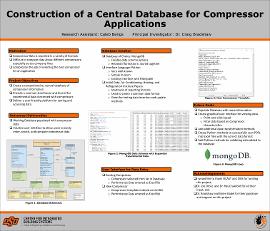| dc.contributor.advisor | Bradshaw, Craig | |
| dc.contributor.author | Bengs, Caleb | |
| dc.contributor.other | Orosz, Joe | |
| dc.contributor.other | Crawford, Roy | |
| dc.contributor.other | Gabel, Kalen | |
| dc.date.accessioned | 2022-04-19T13:18:55Z | |
| dc.date.available | 2022-04-19T13:18:55Z | |
| dc.date.issued | 2022-04-19 | |
| dc.identifier | oksd_URS_2022_bengs | |
| dc.identifier.citation | Bengs, C., & Bradshaw, C. (2022, April 19). Construction of a central database for compressor applications. Poster session presented at the Oklahoma State University Undergraduate Research Symposium, Stillwater, OK. | |
| dc.identifier.uri | https://hdl.handle.net/11244/335246 | |
| dc.description.abstract | Compressors are vital components of everyday life. Although often overlooked by the general public, compressors are used in a wide range of heating and air-conditioning applications, and they account for approximately five percent of the energy consumption in the United States alone. As indicated by recent research on climate change, it is more important than ever to wisely manage energy use in all its forms. Therefore, it is imperative that greater focus be placed on the development and use of more energy-efficient compressors. Nevertheless, progress in this field is often hindered by the lack of a unified format with which to present compressor performance data. Different companies, organizations, and individuals present information about the compressors they have developed or studied in whichever format they prefer. As a result, it can be cumbersome to compare the performance characteristics of different compressors. In the worst case, it can even result in the selection or development of a less efficient compressor for a particular application. In an effort to resolve this problem, a database was created for the purpose of storing compressor performance data in a unified format. Data verification methods ensure that all data contained in the database is consistent, allowing users to easily compare performance data collected with different compressors. Furthermore, the database can even be used to train data-driven or machine learning compressor models. These models will expedite the selection and development of efficient compressors for general and specific applications. Finally, a user interface for data entry will allow new performance data to be entered as it becomes available, ensuring the continued usefulness of the database. | |
| dc.description.sponsorship | Oklahoma Center for the Advancement of Science and Technology | |
| dc.description.sponsorship | Oklahoma State University. Center for Integrated Building Systems | |
| dc.format | application/pdf | |
| dc.language | en_US | |
| dc.publisher | Oklahoma State University | |
| dc.rights | In the Oklahoma State University Library's institutional repository this paper is made available through the open access principles and the terms of agreement/consent between the author(s) and the publisher. The permission policy on the use, reproduction or distribution of the article falls under fair use for educational, scholarship, and research purposes. Contact Digital Resources and Discovery Services at lib-dls@okstate.edu or 405-744-9161 for further information. | |
| dc.title | Construction of a central database for compressor applications | |
| osu.filename | oksd_URS_2022_bengs.pdf | |
| dc.description.department | Mechanical and Aerospace Engineering | |
| dc.type.genre | Poster | |
| dc.type.material | Text | |
| dc.type.material | Image | |
| dc.subject.keywords | compressors | |
| dc.subject.keywords | database | |
| dc.subject.keywords | compressor data | |
